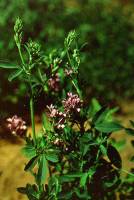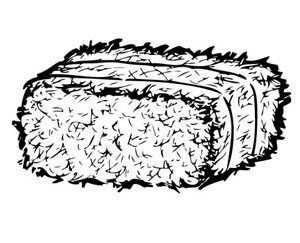Alfalfa
|
|
| Alfalfa | ||||||||||||||||
|---|---|---|---|---|---|---|---|---|---|---|---|---|---|---|---|---|
 | ||||||||||||||||
| Scientific classification | ||||||||||||||||
| ||||||||||||||||
| Species | ||||||||||||||||
Alfalfa (family: Fabaceae, the pea family) is a genus of perennial flowering plant, Medicago, most commonly referring to M. sativa L., also called lucerne.
Alfalfa is a perennial plant, living from five to twelve years, depending on variety and climate. It is a cool-season perennial legume, growing to a height of 1 meter. It resembles clover with clusters of small purple flowers. It also has a deep root system sometimes stretching to 4.5 meters. This makes it very resilient, especially to droughts.
Alfalfa is native to Europe being found worldwide and most likely originated in the middle east, probably in Iran. It is widely grown throughout the world as forage for cattle most often harvested as hay having the highest feeding value of all common hay crops, being used less frequently as pasture or haylage. Like other legumes, its root nodules contain bacteria, like Rhizobium, with the ability to fix nitrogen, producing a high-protein feed regardless of available nitrogen in the soil.
Its wide cultivation beginning in the seventeenth century was an important advance in European agriculture. Its symbiotic relationship with nitrogen-fixing bacteria and use as animal feed greatly improved agricultural efficiency. When grown on soils where it is well-adapted, alfalfa is the highest yielding forage plant.
Alfalfa is one of the few plants that exhibit autotoxicity. Alfalfa seed will not grow in existing stands of alfalfa because of this. Therefore, alfalfa fields must be plowed down or rotated before reseeding.
Alfalfa sprouts are used as salad ingredient in the United States and Australia. The leading Alfalfa growing states are Wisconsin and California, with most of the latter state's production occurring in the Mojave Desert by means of irrigation provided by the California Aqueduct. Alfalfa is believed to be a galactagogue.
A few other species of Medicago are called alfalfa; others are called medick, barrel clover, or burclover.
Culture
Alfalfa can be sown spring or fall and does best on well-drained soils with a neutral pH (6.8-7.5). Alfalfa requires a great deal of potash; soils low in fertility should be fertilized with manure or chemical fertilizer. Usually, a seeding rate of 13 - 17 kg/hectare (12 - 15 lb/acre) in climatic acceptable regions and a rate of 22 kg/hectare (20 lb/acre) in southern regions is used. A nurse crop is often used, particularly for spring plantings, to reduce weed problems. Herbicides are sometimes used instead.
In most climates, alfalfa is cut three or four times a year. Total yields are typically around 1 tonne/hectare (4 ton/acre) but vary regionally and with the weather, and with stage of maturity when cut. Later cuttings improve yield but reduce nutritional content.
The alfalfa leafhopper can reduce yields dramatically, particularly with the second cutting when the weather is warmest. Chemical controls are sometimes used to prevent this. Alfalfa is also susceptible to Texas Root Rot. The plant is also eaten by the larvae of some Lepidoptera species including Latticed Heath.
Alfalfa seed production requires cultured pollinators to be provided for the fields when in bloom. The pollinator of choice is the ground-nesting alfalfa leafcutter bee, which is cultured in special beds near the seed fields, or honeybees which are trucked to the fields when needed.
Harvesting
When alfalfa is to be used as hay, it is usually cut and baled. Loose haystacks are still used in some areas, but bales are much easier to transport. Ideally, the hay is cut just as the field is beginning to flower. When using farm equipment rather than hand-harvesting, the process begins with a swather, which cuts the alfalfa and arranges it in windrows. After it has dried, a tractor pulling a baler collects the hay into bales. There are three types of bales commonly used for alfalfa. Small "square" bales--actually rectilinear, and typically about 15 in x 18 in x 38 in (38 x 46 x 96 cm)--are used for small animals and individual horses. The small square bales can easily be hand separated into "flakes."
Cattle ranches use large round bales, typically 4.5 to 6 feet (1.4 to 1.8 meters) in diameter and weighing upwards of 1,000 pounds. These bales can be placed in stable stacks, placed in large feeders for herds of horses, and unrolled on the ground for large herds of cattle. The bales can be loaded and stacked using a spike on a tractor that pierces the center of the bale or with a grapple (claw) on the tractor's front-end loader.
A more recent innovation is large "square" bales, roughly the same proportions as the small squares, but much larger. The bale size was set so that stacks would fit perfectly on a large flatbed truck.
Varieties
Considerable research and development has been done with this important plant. The "Vernal" variety was introduced c. 1970 and was the standard for years to come. Much better public and private varieties are available now and are adapted to the needs of particular climates.
Most of the improvements in alfalfa over the last decades have been in disease resistance, improved ability to overwinter in cold climates and multi-leaf traits. Disease resistance is important because it improves the usefulness of alfalfa on poorly drained soils, and during wet years.
Multileaf alfalfa has more than three leaflets per leaf. It has a higher nutritional content by weight because there is a relatively more leafy matter for the same amount of stem.



